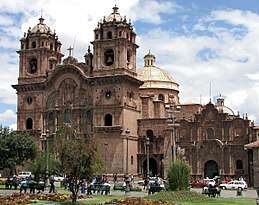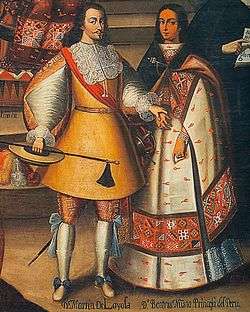Iglesia de la Compañía de Jesús, Cusco
| Iglesia de la Compañía de Jesús | |
|---|---|
 | |
| Location | Cusco |
| Country | Peru |
| Denomination | Roman Catholic |
| History | |
| Founded | 1571 |
| Founder(s) | Flemish Juan Bautista Egidiano, and Diego Martínez de Oviedo |
| Architecture | |
| Style | Baroque |
| Completed | 1668 |
The Iglesia de la Compañía de Jesús (Church of the Society of Jesus) is a historic Jesuit church in Cusco, the ancient capital of the Inca Empire, in Cusco Region, Peru. It is situated in the Plaza de Armas de Cusco, the city center. It is built on a Inca palace.[1] It is one of the best examples of Spanish Baroque architecture in Peru. The architecture of this building exerted a great influence on the development of Baroque architecture in the South of the Andes. Its construction began in 1576, but it was badly damaged in an earthquake in 1650. The rebuilt church was completed in 1668.[2]
History
.jpg)
The construction of the original church was begun in 1571 on the grounds of the old Amarucancha, palace of the Inca Huayna Cápac that was one of the largest palaces surrounding the main square of Qosqo (the Inca capital). The grounds of this palace were given to Hernando Pizarro. Years later the property was purchased from the heirs of the conquistador by Diego de Silva y Guzmán and his wife Teresa Orgoñez, who donated it to the Jesuits long after their arrival to the city in 1571.
In the year 1650, the main church was devastated by the earthquake. This allowed them to make, the following year, a more ambitious reconstruction. Despite the protests of the council, the works continued according to plan and it was reinaugurated in 1668. Although the author of the trace of the current church is unknown (it is said that it was a Flemish Jesuit, Juan Bautista Egidiano (Hispanized name), the works on the façade were directed by Diego Martínez de Oviedo.
Description
.jpg)
The main facade is a classic example of the Baroque style.[3]
The Jesuit college in Cusco was dedicated the Transfiguration of Christ, and the high altar features a painting of the Transfiguration attributed to the Jesuit Diego de la Puente.[4] The most notable piece of art in the church is a painting depicting the wedding of Martín García de Loyola, the nephew of Ignatius Loyola with Beatriz, the great-niece of the Inca ruler Tupac Amaru.[5]
In the church, there are paintings and sculptures by Diego de la Puente, Marcos Zapata, and Cristo de Burgos.[6][7]
Portal
The portal, a "altarpiece" type, presents towers of medium height and its stone walls have been carefully worked. Its towers appear divided into two sections, leaving the lower one free of all decoration, while the upper part has two "balconies" with projecting ledges. At the start of the bell towers, a large flown cornice joins the towers to the front, curving in a trilobed form on the top of it. Finally, the tall body of the towers has a square plan, its portholes, the octagonal dome and the pinnacles, around, define the typical profile of the Cusco bell towers.
Interior

Similar sumptuousness is seen in the carved tribunes and the rest of the altarpieces, some of which belonged to the defunct Templo de San Agustín. Within the collection of sculptures and paintings are splendid, the temple exhibits under the choir of the Main Altar, works of art by Marcos Zapata and his assistant Cipriano Gutiérrez. On both sides of the main gate of the Main Altar - around the alabaster windows (Huamanga) - there are two canvases that represent the life of St. Ignatius of Loyola, in one he is healing the sick and in the other he is victorious over of the heretics and the schismatic people who caused the religious reform.
We also find two paintings of great historical value. The first, located on the northern wall: The Wedding of Martín García Oñas de Loyola with Doña Ñusta Clara Beatriz Qoya, which depicts the union of this Spanish captain, nephew of St. Ignatius of Loyola and apprehender of the last Incas of Túpac Amaru, and the ñusta of Inca lineage, daughter of Sayri Túpac and therefore niece of Túpac Amaru -(this noble indigenouswoman Clara Beatriz was heiress of the Lordship of Yucay. Their mestiza daughter, Lorenza Ñusta de Loyola, was the first Marquiss of Santiago de Oropesa, the nobiliary title that possessed all the properties that were at the Yucay Valley and the surrounding Oropesa with the power to designate with complete independence the local authorities,[8] she married to Juan de Borja y Enríquez de Luna, son of St. Francis Borgia)-; Also on the canvas are Túpac Amaru and Sayri Túpac, who, like the princess, wear native clothes; behind them appears the achiwa, a kind of umbrella made of multicolored bird feathers and used only by the Inca. The second one is on the south wall and represents the wedding of Beltrán García de Loyola with Teresa Idiáquez, daughter of Juan Idiáquez with Magdalena de Loyola.[9]
Chapel of San Ignacio de Loyola

The chapel of San Ignacio de Loyola is located to the south, and at next, today, the central place of the National University of Saint Anthony the Abbot in Cuzco operates. That building originally served the Universidad San Ignacio de Loyola, which was part of the University of the Transfiguration, created by Pope Gregory XV, in 1621. After the Jesuits were expelled in 1767, the site served as the army barracks and prison of José Gabriel Condorcanqui (Túpac Amaru II). At the end-19th century it housed the Society of Artisans. The chapel is small and austere, with a single nave built in stone, with a more sober portal than that of the main church. It is currently an exhibition hall.[9]
University paraninfo
Next to their church, the Jesuits built their own University: "San Ignacio de Loyola", now converted into the premises of the National University of Saint Anthony the Abbot. Paradoxically, both institutions staged a huge rivalry at the end-17th century. The stone façade dates from that time, but its treatment is much freer than that of the main church.
Its composition, like an altarpiece, is adorned with a profuse padding and with blind, purely decorative windows. Its wide hall, crowned by a dome, is unique in Cusco. The inner cloister, which contains an austere stone arcade, served as a model for others in the city. It houses the Museum of Natural Sciences.
The Seminary of San Antonio de Abad was founded in 1598 in a building on the Calle de las Nazarenas (today the Hotel Monasterio); In 1692, through a document given by Pope Innocent XII, the University of Saint Anthony the Abbot was created on its base.[9]
Chapel of Loreto
On the left side of their church, the Jesuits built this chapel to Indigenous between 1651 and 1654. Like the previous one, it is on a more retired plane and its sober decoration does not compete with the main building. Unfortunately, its interior of this chapel does not retain anything of the previous decoration.
References
- ↑ "CUSCO - THE COMPANIA de JESUS CHURCH IN CUZCO - PERU". www.cusco-peru.org. Retrieved 2016-02-11.
- ↑ "La Compañía de Jesús - Cusco, Peru". Sacred-destinations.com. Retrieved 2013-09-08.
- ↑ Main Square, Cusco
- ↑ Wuffarden, Luis Eduardo. "La Procession du Corpus Christi a Cuzco: La communauté de la Merci (les moines de la Merci, autel de la transfiguration)".
- ↑ MacCulloch, Diarmaid (2009). Christianity: The First Three Thousand Years. New York: Viking. pp. 697, and plate 59.
- ↑ "La Compañía de Jesús, Cusco".
- ↑ "CHURCH OF THE COMPAÑÍA DE JESÚS".
- ↑ Guillermo Lohmann Villena (2001), El Corregidor de Indios en el Perú bajo los Austrias, Universidad Pontificia Católica del Perú - Fondo Editorial, ISBN 9972-42-435-9
- 1 2 3 "IGLESIA DE LA COMPAÑIA DE JESUS", cusco-peru.org
External links
| Wikimedia Commons has media related to Compañía de Jesus (Cusco). |
Coordinates: 13°31′2.64″S 71°58′41.5626″W / 13.5174000°S 71.978211833°W